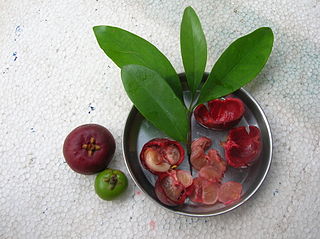
Maharashtra is a state in the western peninsular region of India occupying a substantial portion of the Deccan Plateau. It is bordered by the Arabian Sea to the west, the Indian states of Karnataka and Goa to the south, Telangana to the southeast and Chhattisgarh to the east, Gujarat and Madhya Pradesh to the north, and the Indian union territory of Dadra and Nagar Haveli and Daman and Diu to the northwest. Maharashtra is the second-most populous state in India and the fourth-most populous country subdivision in the world.

Kolhapur is a city on the banks of the Panchganga River in the southern part of the Indian state of Maharashtra.

Alandi is a town and a municipal council in the Pune district in the state of Maharashtra, India. The town is popular as a place of pilgrimage and for being the resting place of the 13th century Marathi saint Sant Dnyaneshwar.

Basmati is a variety of long, slender-grained aromatic rice which is traditionally grown in the Indian subcontinent, mainly India, and Pakistan, as well as some regions of Sri Lanka and Nepal. As of 2019, India accounted for 65% of the international trade in basmati rice, while Pakistan accounted for the remaining 35%. Many countries use domestically grown basmati rice crops; however, basmati is geographically exclusive to certain districts of India and Pakistan.

Bhandara District is an administrative district in the state of Maharashtra in India. The name Bhandara is a corruption of Bhanara. Reference to Bhanara is found in an inscription of 1100 A.D. traced at Ratanpur. The district headquarters are located at Bhandara. The district occupies an area of 3717 km2 and has a population of 1,200,334, of which 19.48% are urban as of 2011. The growth rate of Bhandara is 5.56% Bhandara has a mixed economy with agriculture, industries and forest resources. Bhandara is known for its large production of rice. Tumsar, a tahsil town, is a noted rice market. Bhandara town is also known as "Brass City" owing to the presence of a large brass products industry. Bhandara has several tourist destinations, like Ambagad Fort, Brahmi, Chinchgad, and Dighori.

The Bhima River is a major river in Western and South India. It flows southeast for 861 kilometres (535 mi) through Maharashtra, Karnataka, and Telangana states, before joining the Krishna River. After the first sixty-five kilometers in a narrow valley through rugged terrain, the banks open up and form a fertile agricultural area which is densely populated.

Pune district is a district in Western Maharashtra with Administrative Headquarters in Pune city. Pune district is the most populous district in the Indian state of Maharashtra. It is one of the most industrialised districts in India.

Dehu is a neighbourhood in the city of Pune, India. It is known for being the abode of Sant Tukaram.
Kamshet is a region located in Pune district in the state of Maharashtra, India, 110 km from Mumbai City, and 45 km from Pune in Pune district. It is 16 km from the twin hill stations of Khandala and Lonavala and is accessible by road and rail from Mumbai (Bombay) and Pune. Kamshet is home to small villages that are built in the traditional style - with mud, thatch and reeds.

Mahad ( [məɦaːɖ]) is a city in Raigad district situated in the North Konkan region of Maharashtra state, India. It is located 108.5 km (67.4 mi) from District Headquarters Alibag, and 167 km (104 mi) from Mumbai. Mahad is known for Raigad Fort, the capital of the Maratha Empire in Shivaji Maharaj's era and the revolutionary Mahad Satyagraha launched by at Chavdar Tale in the wake of modern India.

Aromatic rice is one of the major types of rice. It is a medium- to long-grained rice. It is known for its nutty aroma and taste, which is caused by the chemical compound 2-acetyl-1-pyrroline. Varieties of aromatic rice include Ambemohar, Basmati, Jasmine, Sona Masuri, Texmati, Tulaipanji, Tulshimala, Wehani, Kalijira, Chinigura, Gobindobhog, Kali Mooch and wild Pecan rice. When cooked, the grains have a light and fluffy texture except for Gobindobhog rice which is sticky in texture.

Asoli is a small village in Taluka Vengurla and district Sindhudurg of Maharashtra, India.

Ambegaon taluka is a taluka in Shirur subdivision of Pune district of state of Maharashtra in India. One of the twelve most revered Shiva temples or Jyotirlinga, the Bhimashankar Temple is in Khed taluka. But due to Bhimashankar Sanctuary, the road is through Ambegaon taluka.

Garcinia indica, a plant in the mangosteen family (Clusiaceae), commonly known as kokum, is a fruit-bearing tree that has culinary, pharmaceutical, and industrial uses. It grows primarily in India's Western Ghats: in the states of Maharashtra, Goa, Karnataka and Kerala. It is considered as an endemic species to the Western Ghats and forests in India.
The 'Marathwada Kesar mango', is a mango cultivar primarily grown in Marathwada region of Maharashtra, India. Districts where they are primarily grown are Chhatrapati Sambhaji Nagar, Jalna, Beed and Latur.
Ajara Ghansal is a variety of non-Basmati aromatic rice mainly grown in the Indian state of Maharashtra. It is a common and widely cultivated crop in Ajara taluka of Kolhapur district.
Bhandara Chinoor rice is a variety of non-Basmati aromatic rice mainly grown in the Indian state of Maharashtra. It is a common and widely cultivated crop in talukas of Bhandara, Pauni, Tumsar, Mohadi, Sakoli, Lakhani, and Lakhandur of Bhandara district.
Kalonunia rice is a variety of non-Basmati, aromatic, black textured small rice mainly grown in the Indian state of West Bengal. It is a common and widely cultivated crop in districts of Cooch Behar, Jalpaiguri and Alipurduar along with some parts of Darjeeling & Kalimpong districts of West Bengal.
Adamchini Chawal is a variety of non-Basmati, traditional, short-grained aromatic rice mainly grown in the Indian state of Uttar Pradesh. It is a common and widely cultivated crop in Chandauli, Mirzapur, Varanasi and Sonebhadra, and Vindhya region of Eastern Uttar Pradesh.














